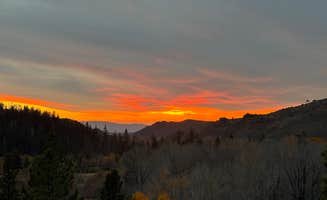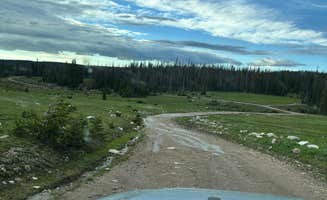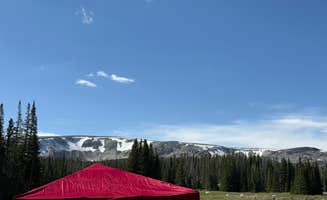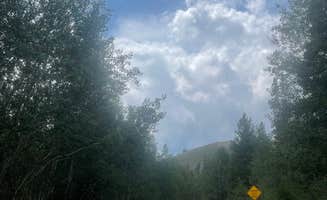The Medicine Bow National Forest provides rustic camping near Hanna, Wyoming with elevations ranging from 7,500 to 10,000 feet. Most dispersed sites sit along forest roads that can become impassable when wet. Summer nights often drop below 40°F even in July, requiring campers to pack warm clothing regardless of season.
What to do
Fishing access: Foote Public Access Area offers primitive camping with boat launch opportunities along the North Platte River. "This is a primitive camping spot with 3 to maybe 5 sites if you are pushing it. Free, with pit toilet. Close to the N Platte, probably good fishing much of the year. I saw a mink and an eagle while there," notes James K.
Wildlife viewing: Several campsites in the Medicine Bow National Forest provide excellent wildlife spotting. One camper at Forest Road 318 reported: "My first choice of dispersed sites was still covered in snow, this ended up being a pleasant surprise. Great views and level site. And moose!" The area supports diverse wildlife including eagles, mink, and larger mammals.
Hiking trails: Stay at sites near Snowy Range for quick access to mountain trails. A camper at Forest Road 318 noted: "Location was a plus - this is within 15 minutes of lots of hikes in the Snowy Range." Most hiking trails remain snow-covered until mid-June, with peak hiking season running July through September.
What campers like
Riverside tranquility: Sanger Access Area receives praise for its riverside location. "Such a tranquil setting, we had the whole place to ourselves. About 3 miles off the beaten path, through the T&A Ranch. We will return," writes Douglas S. The riverside sites provide natural white noise and cooling effects during summer.
Star viewing: Clear mountain skies make stargazing exceptional at higher elevation sites. A camper at East Fork Wagonhound Creek shared: "We got here after dark with our 38' TT, and while the road was a bit rough, we were able to find a site, no problem. Ground isn't level, so make sure you have levelers, but would definitely come back! Clear skies made for unreal star gazing!"
Solitude: Many campers value the quiet nature of dispersed camping in this area. At FS RD 103 Dispersed, one reviewer appreciated the "Solitude and crisp Fall Mornings. Very few other boondockers, and well dispersed. Very quiet with minimal traffic." Most sites see minimal usage except during peak summer weekends and hunting season.
What you should know
Site availability: Most sites operate on first-come, first-served basis with limited spaces. One camper visiting Foote Public Access Area noted: "Definitely only room for maybe 2. The app was also showing at least some bars for Verizon but it's definitely SOS land. Had to turn around. Looks nice if you're lucky enough to get a spot."
Road conditions: Many access roads require appropriate vehicles, especially after rain. A Forest Road 318 visitor warned: "4WD and decent clearance is a must. The road is in rough shape and sections had standing water and mud with deep ruts."
Changing status: Some sites may change usage rules. A Sanger Public Access Area camper reported: "This spot will no longer allow overnight camping. It is day use only." Always check current regulations before travel.
Insects: Mosquitoes present significant challenges during summer months. A camper at Sanger Public Access Area on North Platte River shared: "I had a rough time at this campsite, but I don't want to discount it entirely. There were tons of mosquitoes. My spot was out in the open so when thunderstorms rolled through I opted to sleep in my car."
Tips for camping with families
Riverside options: River access provides natural entertainment for children. At North Platte River Treasure Island, a camper noted: "A dirt road about 1.25 miles leading to a boat ramp, with parking for cars/trailers. There is a bridge with a 12ton limit per vehicle. peaceful and quiet at night with a very nice trail and bridge over the river."
Weather preparation: Mountain weather changes rapidly with thunderstorms common in afternoon hours. Pack extra clothing layers and rain gear even for summer trips. "When you first pull onto FS RD 200 you will wind down past many easy to reach sites with 2wd. Small RVs should be fine as well. If you are going when there is still a lot of snow melt (through late June) I would recommend 4x4 the further back you go," advises one FS RD 103 camper.
Space needs: Look for sites with room for multiple tents if camping with extended family. Laramie Overlook Dispersed Camping offers options: "There are a couple of loops right as you enter, which are the most level places to park a rig. Then another path leads about a half a mile to a few other sites that are more secluded, but not very level."
Tips from RVers
Leveling requirements: Few primitive camping spots around Hanna offer naturally level terrain. One RVer at Laramie Overlook Dispersed Camping shared: "Great place to boondock for a few days. We stayed here for a week in our 20 foot skoolie. There are a couple of loops right as you enter, which are the most level places to park a rig."
Size limitations: Large rigs face significant challenges on forest roads. A 36-foot fifth wheel owner at White Rock Canyon noted: "The road has washboard and is quite steep in places. The biggest issue was finding a place to turn around. We did find a place to stay but most were already filled with hunting campers that had been brought up and left."
Cell coverage: Work-from-RV campers should research connectivity. The same White Rock Canyon camper reported: "We work from our camper so cell service was important. T-mobile was dismal, but Verizon was usable with a solid 4G 2bars."












